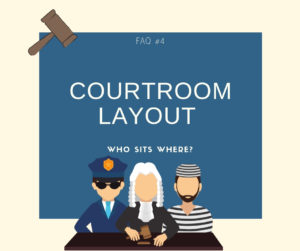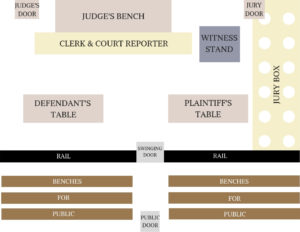Courtroom Layout: Who Sits Where?
Going into a courtroom for the first time can be an unsettling experience. The rooms are large and often overwhelming, and their layout is both confusing and intimidating. Here, we hope to demystify the courtroom layout and walk you through the courtroom from back to front.
The Public Seating Area
You will enter most courtrooms from the rear. The rear half of the room contains benches or chairs and is where the public sits when they come in. As you move from the public seating toward the front of the courtroom, you will see a railing, often with a swinging door. This railing divides the public seating area from the “well of the court.” The “well of the court” is a phrase that describes the area where court proceedings are conducted.
Inside the Well of the Courtroom
Counsel Tables
Counsel tables are at the back of the well. This is where lawyers and their clients sit during court trial or other court proceedings. Typically, the Plaintiff’s table is on the right side, and the Defendant’s table is on the left side. However, the Plaintiff’s side has the right to sit closest to the jury box. Very often, you will see a secured door on one side of the courtroom and see a deputy positioned beside it. This door is often used by Sheriff’s deputies and persons who are in custody (jail).
Jury Box
The jury box is placed along one side of the well. It’s easy to spot because there are usually 2-3 rows of about 12 upholstered chairs situated inside a large railing or partial enclosure. There is often a door near the jury box, and jurors may use that door to exit the courtroom after a trial when they go into another room to deliberate. Often, the lawyers will sit in the jury box and either visit with one another or mentally prepare for the court to begin.
Judge’s Bench
At the very front of the courtroom is the judge’s “bench.” It’s not an actual bench. It’s usually a raised platform with a partial rail or enclosure that the judge sits behind. Near the bench, you will also find a secured door. The judge and courtroom personnel may use this secured door to access the judge’s chambers or other offices. The term “chambers” just means the judge’s office.
Directly in front of the judge’s bench, you will usually see chairs and computer workstations for 2-3 people. One chair is always for the courtroom clerk, who handles case files and paperwork. A court reporter may use another, and judge’s law clerk may occupy a third chair. A law clerk is an attorney who works for the judge and assists the judge in conducting the business of the Court.
Witness Stand
Between the judge’s bench and the jury box is the witness stand. This is where testifying witnesses will sit while they are giving testimony in a case. You may or may not see a Bible near the witness stand. You can read more about what to do (and not do) on the witness stand here.
Between the judge’s bench, the jury box, and the counsel tables is a large, vacant area. Lawyers will often address the judge or jury or question witnesses from this area, and you may see a podium available for the lawyers to use.
While this layout may vary from courtroom to courtroom, the basics will be in place each time.


